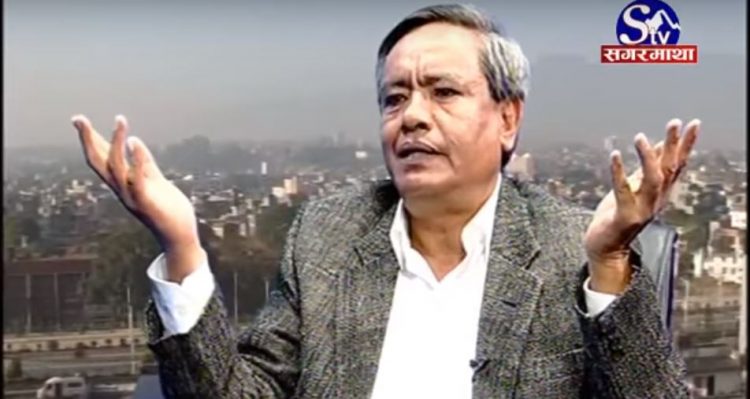Ram Karki’s ridiculous claims
Sujit Mainali / November 7, 2017

Maoist Center leader Ram Karki Source: Youtube
Leader of the CPN (Maoist Center) and former communications minister Surendra Kumar Karki (better known as Ram Karki) made several claims during an interview aired on Sagarmatha TV on November 5. South Asia Check has examined whether the following two claims are fact-based or not:
First Claim: Jhapa district’s parliamentary constituency number 1 alone has more languages than any other zone or province of Nepal.
According to ‘Nepali Population and Housing Census, 2011’, 72 languages are spoken in Jhapa district. Even if we assume that all these languages are spoken in the district’s constituency number 1, then still it would be wrong to say the constituency has more languages than any other district or zone. According to the census report, Jhapa’s neighboring district Morang also has 72 languages and 80 languages are spoken in Kathmandu district.
Therefore, Karki’s claim is wrong.
Second Claim: If we grow rice efficiently in 2,000 bigha of land, then it will be enough to meet the rice requirement of half of the population of Nepal.
According to the Ministry of Agriculture Development, 2,374,389 metric tons of rice was produced in the fiscal year 2015/16. This covered 43.75 percent of the total requirement of food in Nepal that year (Statistical Information on Nepalese Agriculture, Pg 131-33, 2015/16, Ministry of Agriculture Development).
Assuming that the total rice produced in Nepal this year was enough to meet the rice requirement of the country, we can say that 11,87194.5 metric tons of rice was needed to meet the rice requirement of country’s half of the population in that year.
US is among the countries with highest rice productivity. In 2015, US produced 8.37 metric tons of rice per hectare.
Even if we are able to boost our rice productivity to match that of the US through use of advanced agricultural technologies and better seeds, we can produce 11,337.41 metric tons rice from 2000 bigha [1354.53 hectares] of land. And this amount will still fall short of 1,175,857.09 metric tons to meet the rice requirement of half of the population of Nepal.
If, through some sheer miracle, we succeeded in boosting our rice productivity by 100 times than that of the US, we could produce 1,133,741.61 metric tons of rice. But we would still require another 53,452.89 metric tons to fulfill rice requirement of half of the population of the country. Therefore, Karki’s claim is preposterous.
This material is copyrighted but may be used for any purpose by giving due credit to southasiacheck.org.
Comments
Latest Stories
- In Public Interest Covid-19 cases are low, but that’s not an excuse to avoid vaccination
- In Public Interest What is BF.7, the sub-variant that has the world by its grip?
- In Public Interest Threat of a new Covid-19 wave looms large amid vaccine shortage in Nepal
- In Public Interest As cases decline, Covid-19 test centres in Kathmandu are desolate lot
- In Public Interest Dengue test fee disparity has patients wondering if they’re being cheated
- In Public Interest As dengue rages on, confusion galore about what it is and what its symptoms are. Here’s what you need to know
In Public Interest
 Covid-19 cases are low, but that’s not an excuse to avoid vaccination
The Pfizer-BioNTech bivalent vaccines authorised by the Nepal Government provide better protection a...
Read More
Covid-19 cases are low, but that’s not an excuse to avoid vaccination
The Pfizer-BioNTech bivalent vaccines authorised by the Nepal Government provide better protection a...
Read More
- What is BF.7, the sub-variant that has the world by its grip?
- Threat of a new Covid-19 wave looms large amid vaccine shortage in Nepal
- As cases decline, Covid-19 test centres in Kathmandu are desolate lot
- Dengue test fee disparity has patients wondering if they’re being cheated
- As dengue rages on, confusion galore about what it is and what its symptoms are. Here’s what you need to know